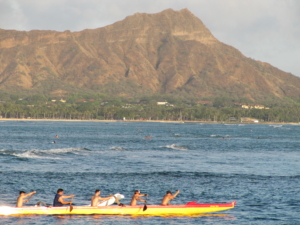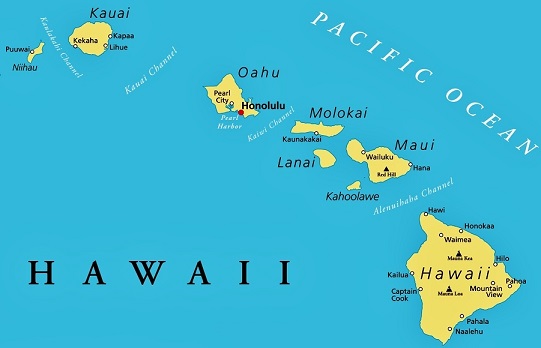The History of Hawaii: From Fire, Tears and Blood, A Tree of Liberty Blooms
LISTEN ON SOUNDCLOUD:
Born of ancient volcanoes in Earth’s prehistory and baptized by fire into the modern era by the bombs of the Imperial Japanese attack on Pearl Harbor, the history of the Fiftieth State is nothing short of legendary.
First discovered and populated by seafaring Polynesian peoples perhaps around the 12th century or even earlier, Hawaii would be thrust into global destiny by European contact when British Captain James Cook discovered and sailed past the island of Oahu on January 18, 1778. As a midpoint in the Pacific, the Hawaiian Islands would soon become a key strategic shipping hub that attracted merchants, missionaries, and militaries alike from around the world.
The relevance of Hawaii would endure long beyond the Age of Sail, as the United States by the end of the 19th century had overtaken all the European powers as an industrial powerhouse. Protection of American shipping routes, defense of the West Coast, and access to Asia necessitated a forward naval presence in Hawaii, and in 1887, the U.S. military began leasing Pearl Harbor.
American influence had already been growing in Hawaii since the end of the Civil War due to the need for sugar cane amidst economic devastation in the South, and the Reciprocity Treaty of 1875 cemented the Islands as a leading driver of the growing U.S. economy when it created a free trade agreement for agricultural products from the Kingdom of Hawaii.
Having already seen European military rivals make power plays for control of Hawaii, American business interests maneuvered for decisive U.S. control of the islands. In 1893, Hawaii’s monarchy dissolved and Queen Liliuokalani was pressured by local militias to abdicate her throne. Ultimately, it would be the Spanish-American War which put the U.S. in conflict on distant shores as far away as the Philippines and Guam, that would give the U.S. justification to annex Hawaii.
On July 4, 1898, just four months after the sinking of the Battleship Maine in Havana Harbor, the U.S. Congress adopted Senate Joint Resolution 55 – nicknamed the “Newlands Resolution” after its introducer, Democratic Rep. Francis G. Newlands of Nevada – which set the framework for annexation of Hawaii. On August 12, 1898, a small ceremony on the steps of Hawaii’s Iolani Palace marked the formal annexation of Hawaii and its transfer of sovereignty to the United States.
Pearl Harbor and the Road to Statehood
At the dawn of the 20th century, political shifts in Asia, not Washington D.C., would set the stage for Hawaii’s most significant moment in American and world history. Japan, having dashed the Russian Navy’s hopes for a Pacific warm water port in the spectacular 1905 Battle of the Tsushima Strait, saw herself as an emerging world military power, even on-par with the great European nations.
As a participant in the First World War, Japan’s seizure of Germany’s Pacific territories led the Imperial government to believe it had an important seat at the table as part of the victorious Allies at the Paris Peace Conference of 1919.
Much to the Japanese dismay, the U.S. and European powers treated members of the Imperial delegation as bit players in the Treaty of Versailles. The tense peace that followed was only underlined further by the Washington Naval Treaty of 1922 which limited the construction of battleships and prevented the construction of any new Pacific Ocean military bases – making Hawaii, as an existing U.S. naval and army forward base, perhaps the most strategically relevant island in the entire world.
As Japan, the U.S., and the Europeans all sought to expand in a world that the machines of the Industrial Revolution made even smaller, a perfect storm of interests, politics, and geography was brewing that would one day rain bombs over Hawaii.
This confluence of international politics and geography could lead only to Japanese fighter planes over Oahu on the fateful morning of December 7, 1941. Colliding over the azure blue waters and exotic green jungles of Hawaii were more than just Japanese and American forces, but two competing destinies of fascism or freedom.
The attack on Pearl Harbor would not only steel the U.S. resolve to defeat the Axis Powers, but the terrible east wind rain of Imperial Japanese bombs had a more dynamic effect in that they aroused many Hawaiians to see themselves as a vital part of the American experience. Fighting not only for the safety of their islands but also for the freedom of their way of life, when America triumphed in World War II, Hawaiians felt a special place as part of the victory that liberated the world.
Hawaii’s Statehood and Constitution: A Model for the Future
The immediate post-WWII era saw intense enthusiasm among many locals to petition for Hawaii statehood, bringing together religious, cultural, academic, labor, political, and business leaders in calls to make Hawaii part of the Union. America had become the world’s first superpower, and Hawaii had been the pivot point for the dawn of an American century.
In 1950, Hawaii’s Constitutional Convention was a key step towards statehood for the Territory of Hawaii, as many delegates felt that it showed for the first time in history that Hawaii was ready for statehood.
Though Democrats in Congress had staunchly resisted Republican-leaning Hawaii from entering the Union, unresolved postwar tensions with the Soviet Union and the Cold War could not afford a lingering question mark in the Pacific Ocean. Hawaii, which had been so essential to winning WWII, would be crucial for containment of the Soviet Union and access to Asia in a nuclear world.
On March 18, 1959, Congress passed the Hawaii Admission Act, which at last provided for Hawaii’s ascension to full statehood. Section 3 of the Act would proudly declare, “The constitution of the State of Hawaii shall always be republican in form and shall not be repugnant to the Constitution of the United States and the principles of the Declaration of Independence.”
On June 27, 1959, Hawaii voted for statehood, a leap of faith which helped mollify the political and cultural divisions of the past, as locals finally had the chance to determine Hawaii’s place in the world for themselves. No longer under the supervision of a monarch or held at bayonet point, the people of Hawaii were given the chance to choose for themselves the future.
They voted “yes.”
In a landslide victory for statehood, 132,773 voters, or 94.3 percent of the vote, cast their ballots to become the Fiftieth State.
As the most recent state to enter the Union, Hawaii’s constitution represents the most modern, elegant, and in many instances, poetic social compacts among the States. Hawaii is especially unique in that every decade, voters are given the option to vote for a recurring Constitutional Convention question, which continues to place the future of Hawaii in the hands of Hawaiians.

The most recent revision to the Hawaii Constitution’s Preamble reminds the world, “We reserve the right to control our destiny, to nurture the integrity of our people and culture, and to preserve the quality of life that we desire. We reaffirm our belief in a government of the people, by the people, and for the people, and with an understanding and compassionate heart toward all peoples of the earth, do hereby ordain and establish this constitution for the State of Hawaii.”
In the annals of history, the story of mankind is one of mistakes and injustices, but also triumphs and great honors. History has not always been right or kind, but history in America is our story, which we have the freedom to change. In the volcanic soil of Hawaii, scarred by war and upheaval, and watered by the blood and tears of so many, a tree of liberty has grown in the Pacific whose fruits give us hope for the future of our planet.
In 1993, Congress and President Bill Clinton issued the Apology Resolution which acknowledged the overthrow of the Kingdom of Hawaii. While some Native Hawaiians continue to feel grieved over the loss of their sovereignty, the 1993 Apology Resolution was a helpful part of Hawaii’s healing and progress. Today, the majority of Hawaiians and Hawaii residents continue to proudly and patriotically support the State of Hawaii and their place as American citizens.
Though today’s Hawaii struggles with many economic, political, and cultural issues, the sons and daughters of Hawaii represent the blossoming of a great generation of Americans who will continue to further the relevance of our United States of America for centuries to come. As someone whose family was among the very first Filipino plantation immigrants to come to Hawaii, my experience is particularly special, because my family has had the joy of becoming citizens of Hawaii and citizens of these United States.
May God forever bless the State of Hawaii, and all those who live in it.
Dr. Danny de Gracia, Th.D., D.Min., is a political scientist, theologist, and former committee clerk to the Hawaii State House of Representatives. He is an internationally acclaimed author and novelist who has been featured worldwide in the Washington Times, New York Times, USA Today, BBC News, Honolulu Civil Beat, and more. His first novel, “American Kiss: A Collection of Short Stories” is available online on Amazon.com, Barnes and Noble, and other retail outlets.
Click Here to have the NEWEST essay in this study emailed to your inbox every day!
Click Here to view the schedule of topics in our 90 Day Study on Congress.




Join the discussion! Post your comments below.
Your feedback and insights are welcome.Feel free to contribute!